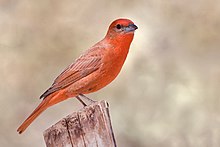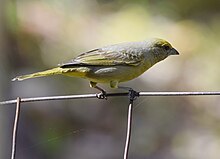| Hepatic tanager | |
|---|---|

| |
| male in Arizona | |

| |
| female | |
| Conservation status | |
 Least Concern (IUCN 3.1) | |
| Scientific classification | |
| Domain: | Eukaryota |
| Kingdom: | Animalia |
| Phylum: | Chordata |
| Class: | Aves |
| Order: | Passeriformes |
| Family: | Cardinalidae |
| Genus: | Piranga |
| Species: | P. hepatica |
| Binomial name | |
| Piranga hepatica Swainson, 1827 | |

| |
| Passage Year-round Breeding | |
The hepatic tanager (Piranga hepatica) is a medium-sized American songbird. Formerly placed in the tanager family (Thraupidae), it and other members of the genus Piranga are now classified in the cardinal family (Cardinalidae).
Etymology
The common name hepatic means "liver-coloured", namely, brownish-red.
Taxonomy
The IOC World Bird List recognises five subspecies of Piranga hepatica, found in North and Central America.
- Piranga hepatica hepatica Swainson, 1827 (California, Arizona, and New Mexico in the United States and Oaxaca in western Mexico)
- Piranga hepatica dextra Bangs, 1907 (New Mexico and western Texas in the United States, Chiapas in eastern Mexico (to Chiapas), and western Guatemala)
- Piranga hepatica figlina Salvin & Godman, 1883 (eastern Guatemala and Belize
- Piranga hepatica savannarum T.R. Howell, 1965 (eastern Honduras and northeast Nicaragua)
- Piranga hepatica albifacies J.T. Zimmer, 1929 (highlands of eastern Guatemala and Nicaragua)
Other taxonomic authorities don't recognise Piranga hepatica as a distinct species and include it in Piranga flava, a more broadly defined hepatic tanager, with a range from the United States to Argentina. These authorities recognise three subspecies groups, which are recognised as three species by the IOC. According to this taxonomy the three subspecies groups and their subspecies are as follows:
- the hepatica group (northern hepatic tanager), breeding from Nicaragua northwards to the United States, in pine and pine-oak forests and partially migratory. This is the species Piranga hepatica as recognised by the IOC, with the five subspecies listed above.
- the lutea group (highland hepatic tanager), resident from Costa Rica to northern and western South America in highland forest edges. The IOC recognises these subspecies as the species Piranga lutea (the tooth-billed tanager).
- Piranga hepatica testacea P.L. Sclater & Salvin, 1868 (highlands of northern Costa Rica and eastern Panama)
- Piranga hepatica faceta Bangs, 1898 (Santa Marta Mountains in northern Colombia, mountains of northern Venezuela and Trinidad)
- Piranga hepatica haemalea Salvin & Godman, 1883 (Amazonas and Bolívar in southern Venezuela, the Guianas, Serra Imeri in northern Brazil)
- Piranga hepatica toddi Parkes, 1969 (mountains of central Colombia)
- Piranga hepatica desidiosa Bangs & Noble, 1918 (southwestern Colombia)
- Piranga hepatica lutea (Lesson, 1834) (southwestern Colombia and northwestern Bolivia)
- the flava group (lowland hepatic tanager), resident in open woods elsewhere in South America. The IOC recognises these subspecies as the species Piranga flava (the red tanager).
- Piranga hepatica macconnelli C. Chubb, 1921 (southern Guyana, southern Suriname and northern Brazil)
- Piranga hepatica rosacea Todd, 1922 (eastern Bolivia)
- Piranga hepatica saira (von Spix, 1825) (eastern and southern Brazil)
- Piranga hepatica flava (Vieillot, 1822) (southeastern Bolivia, Paraguay, northern Argentina and Uruguay
The IUCN follows another taxonomy, recognising Piranga hepatica (hepatic tanager) and Piranga flava (red tanager), with the former including the subspecies includes in the hepatica and lutea groups.
Description
The species's plumage and vocalizations are similar to other members of the cardinal family.
The hepatic tanager is a strongly built songbird up to 20 cm long with a short and quite thick beak and long wings and tail. The male is greyish brick-red above, reddish below with greyish ear-coverts. The female is olive yellow above, yellowish below with soot colored ear coverts. Both sexes have dark beaks and dark legs. The song is a three to four second long beautiful and thrush-like series, but also reminiscent of a black-capped cardinal. The most common sound is rendered in English literature as a clipped "tchup", while in flight it sometimes emits a soft, scream-like "wenk".
Habitat
Hepatic tanager is found in open mountain forests with pine or pine and oak. There it is seen jumping slowly upwards in trees and bushes in search of food, but can also catch flying insects by lunging. It is often found in pairs or small groups, probably families. The nest is placed in a cleft far out on a branch, about 15 to 30 meters above the ground. There she lays three to five eggs.
Behavior
The habits of the hepatic tanager are similar to those of the western tanager.
Its call is a low, dry chup like the hermit thrush. Its song is clearer than Thraupidae tanagers and far more similar to the song of the black-headed grosbeak, another member of the Cardinalidae. The flight call is a husky and rising weet.
Feeding
It looks for food in the foliage of trees, moving slowly and methodically; different individuals use different strategies. In summer, the northern form largely eats insects, spiders and some fruit. In Mexico, it has been observed to eat nectar. From Oaxaca south, it follows swarms of army ants.
References
- BirdLife International. (2019). "Piranga hepatica". IUCN Red List of Threatened Species. 2019: e.T103811627A138437427. doi:10.2305/IUCN.UK.2019-3.RLTS.T103811627A138437427.en. Retrieved 28 April 2024.
- "hepatic". Oxford English Dictionary (Online ed.). Oxford University Press. (Subscription or participating institution membership required.)
"(adj.) Liver-coloured, dark brownish-red; as in hepatic aloes, hepatic tanager." - ^ Sibley, David (2003). The Sibley Field Guide to Birds of Western North America. Knopf. ISBN 0-679-45121-8.
- ^ Gill, F.; Donsker, D.; Rasmussen, P. (eds.). "Cardinals, grosbeaks and "tanager" allies". IOC World Bird List. International Ornithological Congress. Retrieved 28 April 2024.
- ^ "Cardinalidae Cardinals and Allies". Birds of the World Online. Cornell Lab of Ornithology, Ithaca, NY. Retrieved 28 April 2024.
- ^ "The Family Cardinalidae". Howard & Moore checklist. 4.1. The Trust for Avian Systematics. Retrieved 28 April 2024.
- ^ Eddleman, William R. (2002). Poole, A. (ed.). "Hepatic Tanager (Piranga flava)". The Birds of North America Online. Ithaca: Cornell Lab of Ornithology. Archived from the original on December 10, 2012.
- Error: unrecognised source.
- Gill, Frank & Donsker, David (eds.). "IOC World Bird List". Retrieved 16 September 2020.
- ^ Hepatic Tanager @ allaboutbirds.org
External links
- Hepatic tanager Species Account – Cornell Lab of Ornithology
- Hepatic tanager Stamps from Paraguay at bird-stamps.org
- Hepatic tanager photo gallery at VIREO (Drexel University)
- "Lowland hepatic tanager media". Internet Bird Collection.
- Hepatic tanager species account at Neotropical Birds (Cornell Lab of Ornithology)
- Audio recordings of Hepatic tanager on Xeno-canto.
| Taxon identifiers | |
|---|---|
| Piranga hepatica | |
- IUCN Red List least concern species
- Piranga
- Birds of Central America
- Native birds of the Southwestern United States
- Birds of the Rio Grande valleys
- Birds of Mexico
- Birds of the Sierra Madre Occidental
- Birds of the Sierra Madre Oriental
- Birds of the Sierra Madre del Sur
- Birds of the Trans-Mexican Volcanic Belt
- Birds described in 1827
- Taxa named by William Swainson